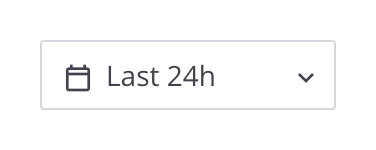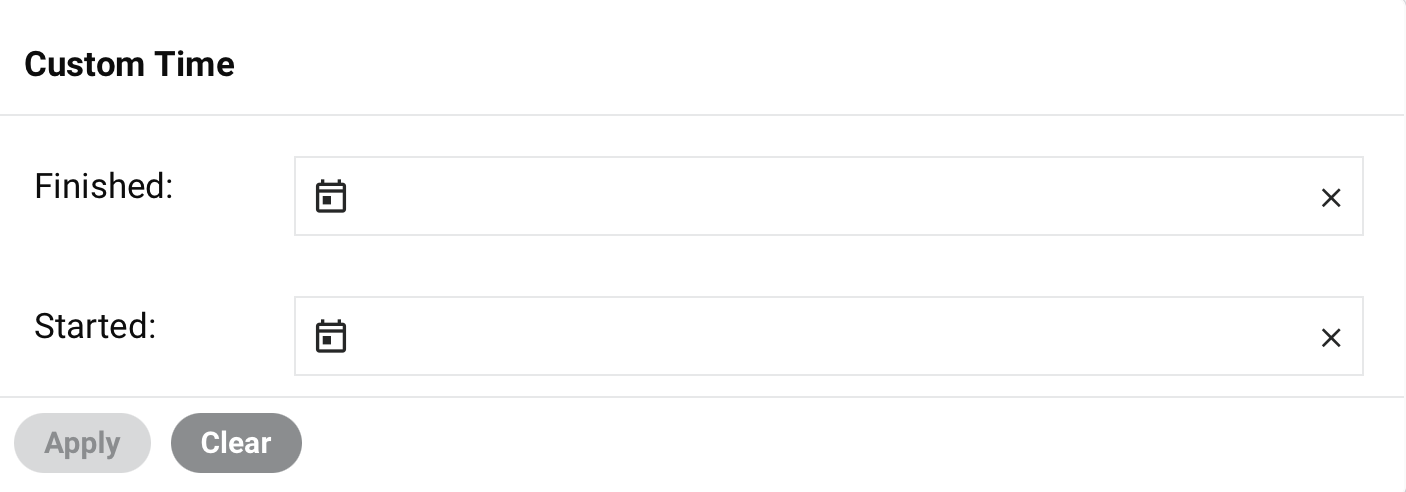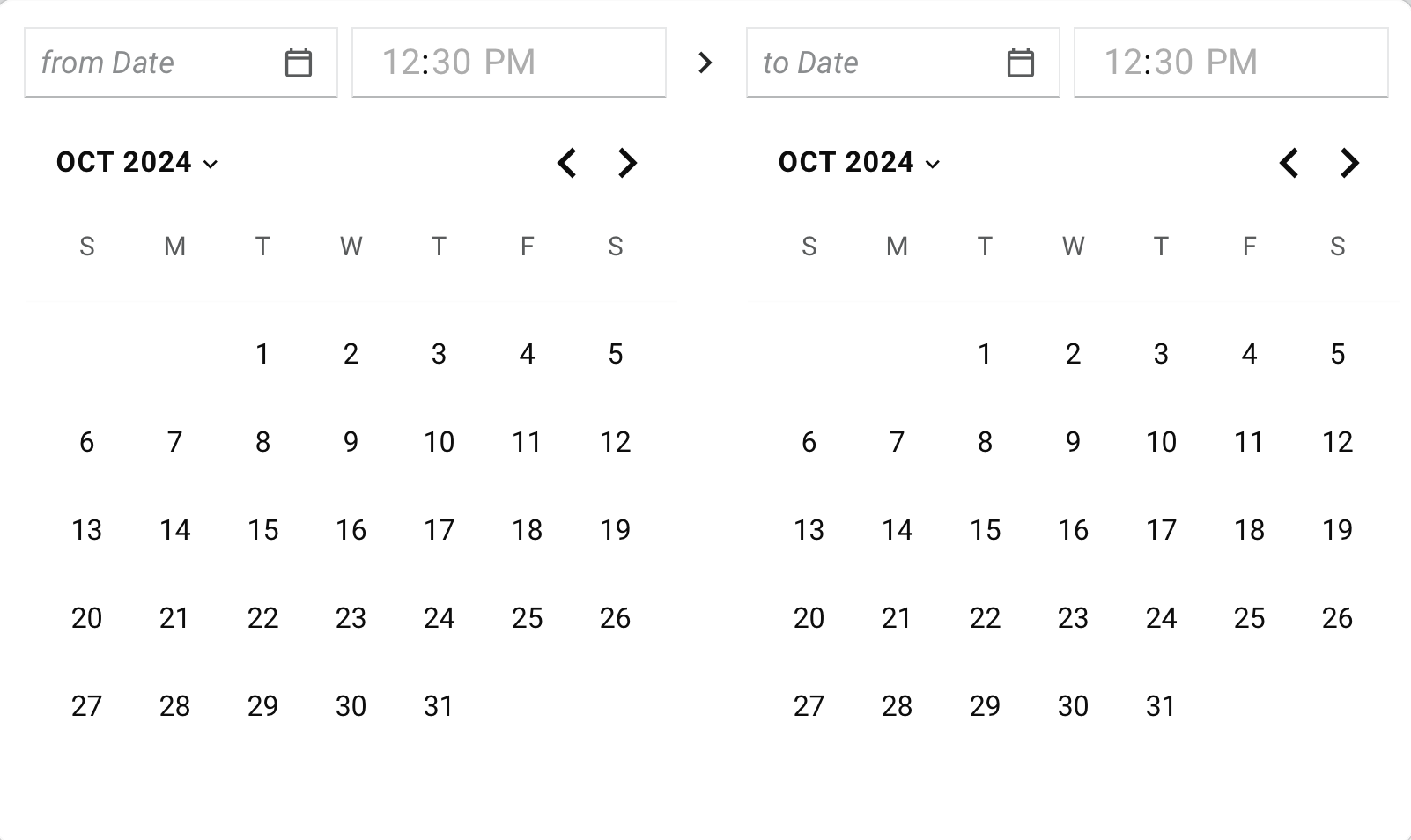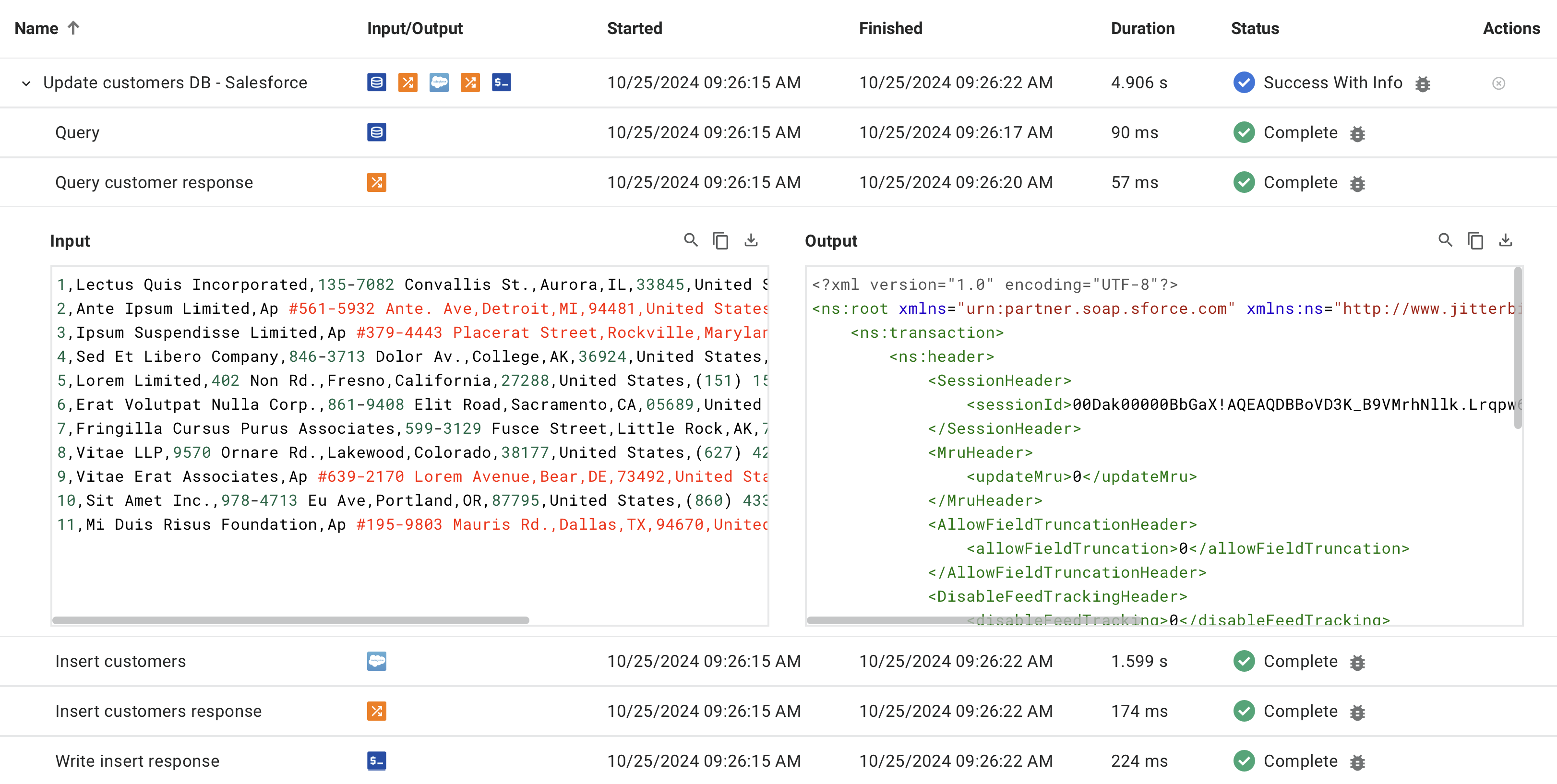Operation logs in Jitterbit Studio
Introduction
When an operation is executed, an operation log is generated. An operation log contains information about when and where an operation ran, the operation status, and any log messages. Whether detailed log messages are displayed depends on permission and access levels and whether cloud logging is enabled. When operation debug logging (for cloud agents or for private agents) is enabled for an individual operation, each operation log also contains input and output data for the operation.
Operation logs, including detailed log messages from both cloud agents and private agents, and component input and output data within operation logs, are retained for 30 days by Harmony.
Operation logs can also be viewed on the Management Console Runtime Operations page.
Important
By default, successful API operations (configured for custom APIs or OData services) are not included in the operation logs unless one of these settings is enabled:
- Cloud agents: For API operations on a cloud agent, operation debug logging must be enabled on the operation.
- Private agents: For API operations on a private agent, either operation debug logging must be enabled on the operation or you must set
EnableLogging=truein the[APIoperation]section of the private agent configuration file.
For information on resolving certain errors that may occur when executing an operation, see Operation troubleshooting.
Access operation logs
Operation logs can be accessed in Studio at the workflow, operation, or project level. Depending on where they are accessed, the operation log screen includes a maximum of 1,000 logs for a given timeframe for operations that have been executed in a particular workflow, for a particular operation, or in a project, respectively. If operations are linked with operation actions or the RunOperation function, logs for downstream operations are also included.
By workflow
The View Logs option for a workflow, which shows logs for operations that have been executed within a particular workflow, can be accessed from the project pane's Workflows tab (see Workflow actions menu in Project pane Workflows tab).
By operation
The View Logs option for an operation is accessible from these locations:
- The project pane's Workflows tab (see Component actions menu in Project pane Workflows tab).
- The project pane's Components tab (see Component actions menu in Project pane Components tab).
- The design canvas (see Component actions menu in Design canvas).
In addition, after running an operation manually, you can click the operation status on the design canvas to display the logs (see Operation status in Operation deployment and execution).
By project
When using a project's View Logs option, the Management Console's Runtime Operations page is opened in a new browser tab and is filtered to display logs for operations that have been executed within the project.
The View Logs option for a project can be accessed from these locations:
- The Projects page (see Card view or List view in Projects).
- The project toolbar (see Project actions menu in Project toolbar).
Note
The remainder of this page covers the operation log user interface for workflows and operations. For information on viewing operation logs for an entire project, see Runtime Operations.
Project drawer's operation log tab
When you view logs by workflow or operation, the project drawer opens along the bottom of the design canvas to maintain your context in the project. The operation logs display in a split view, with the operations list on the left and detailed log information for the selected operation on the right.

- Tabs: Tabs along the top of the drawer are labeled with Logging followed by the name of the operation or workflow (depending on where the logs were accessed from). When you access additional logs or project variables, new tabs are added. To reorder tabs, drag and drop a tab. To close a tab, click its close icon. Closing the last tab or using the rightmost close icon closes the drawer.
- Resize: The bar along the top of the drawer can be used to resize the drawer. Hover over the bar and drag the resize icon up or down to resize the drawer.
- Collapse: Collapses the drawer so that all logs are hidden. Once collapsed, click the return icon to return to the previous view.
- Expand: Expands the drawer to full screen so that any additional logs are displayed. Once expanded, click the return icon to return to the previous view.
- Open in Runtime Operations: Opens the currently accessed operation log tab with any applied queries in the Management Console Runtime Operations page. Timeframe filters are not retained and must be reapplied in the Runtime Operations page.
- Close: Closes the drawer.
Operation log table controls
The operation log drawer view includes filters for timeframe and queries, and table refresh.
Timeframe
All timeframes are displayed as the local browser time. By default, the timeframe is set to the Last 24 Hours of logs since last running an operation. Alternatively, use the menu to select Last 48 Hours, Last 72 Hours, or Custom time:

For a given timeframe, a maximum of 1,000 logs are included in the operation log table.
Note
Operation logs are stored for a maximum of 30 days.
When Custom time is selected, a configuration dialog opens:

- Finished: To filter by the date and time the operation or operation step stopped running, click the calendar icon to open the date picker. To clear this field, click the clear filter icon.
- Started: To filter by the date and time the operation or operation step started running, click the calendar icon to open the date picker. To clear this field, click the clear filter icon.
- Apply: (Enabled when either the Finished or Started fields are configured.) Applies all date and time filters to the operation logs table.
- Clear: (Enabled when either the Finished or Started fields are configured.) Clears both Finished and Started filters.
Once a calendar icon is clicked, the date/time picker is opened for that field:

-
From/To Date: Use the calendar under one or both of these fields to select a date within the last 30 days.
-
Month: The current month is used by default. Use the arrows to navigate to a different month.
-
Day: Select the desired day from the calendar.
-
-
Time: Type the hour, minute, and time period (
AMorPM).
Refresh
Logs are automatically refreshed every five seconds if any operation is still in a running state (status of Received, Submitted, Pending, or Running).
You can also manually refresh the logs at any time to display updated information. To manually refresh the logs, click the Refresh icon along the top right.
Queries
A query is one or more key/value terms. Multiple terms are separated by semicolons. A term has the form <key><operator><value>. For the operation key, the value can include a wild card character, %, which matches any string.
To use a query, enter a valid query specification in the search bar then press return:

The following table shows the available query term components:
| Key | Key column | Allowed Operators |
Value1 |
|---|---|---|---|
name or operation |
Name | = |
Operation name |
status |
Status | = |
Status name |
started |
Started | <= |
Date/time |
>= |
|||
finished |
Finished | <= |
Date/time |
>= |
|||
message |
n/a | n/a | Operation log message |
1 Value types
- Status name: The string shown in the Status column of the operation logs table.
- Date/time:
month/day/yeardate format, with optionalhour:minute:secondtime in AM/PM form:- Date only:
MM/DD/YYYY - Date and time (AM):
MM/DD/YYYY HH:MM:SS AM - Date and time (PM):
MM/DD/YYYY HH:MM:SS PM
- Date only:
Operation statuses
The following are statuses that can be queried when using the status key:
-
Error: If the agent completes the execution of an operation, but there was a fatal error in writing to the target system, or there was a fatal validation error in the transformation, or the transformation logic triggered the
RaiseErrorfunction, then the operation status is set to Error and the operation execution terminates. -
SOAP Fault: If the agent completes the execution of an operation, and the outcome was a SOAP fault, then the status is set to SOAP Fault. This status is applicable only for operations using Salesforce, Salesforce Service Cloud, ServiceMax, SOAP, or Workday activities.
-
Submitted: When operations are submitted to the Harmony queue, but have yet to be picked up by an agent for execution, they have a Submitted status. Operations can be submitted by several means:
- Jitterbit scheduling service or external scheduling service
- Manual execution of the operation in Studio
- A
RunOperationfunction from a script or transformation - Any tool, including
JitterbitUtils, that calls an API Manager API
-
Received: Once an agent is picked and the agent has acknowledged that it has received the request to run an operation, the status is changed to Received.
-
Pending: Once an operation is scheduled to run in an agent's operation engine, the status is changed to Pending. Operations should not be in Pending status for long durations, as agents should pick up the request and start running operations in a short amount of time.
-
Running: Once the agent starts executing an operation, the status should change to Running. Operations remain in this status until they complete or they encounter an error. The agent starts logging messages generated by the operation as it runs so that users can track which part of the operation is currently being executed.
-
Cancel Requested: Indicates that a request to stop the operation has been submitted. If a user wants to stop an operation that is in Submitted, Received, Pending, or Running status, they can do so from these locations:
- The operation (see runtime status in Design canvas).
- The operation log table.
- The Runtime Operations page of the Management Console (see Canceling runtime operations).
Alternatively, they can enable another operation to cancel an operation using a combination of the
GetOperationQueueandCancelOperationfunctions. Once a cancel is requested, the operation status changes to Cancel Requested. An operation should not remain in this status for long, as the agent should cancel the operation in a fairly short period of time. -
Canceled: Once an agent cancels an operation, it sets the status to Canceled and the operation is terminated. All log information up to the point of cancellation is available for review in the log messages so you know at which point the operation was canceled.
-
Success: Once an agent completes the execution of an operation, if the outcome was a success without warnings from the target system, or warning written in the transformation using the
WriteToOperationLogfunction, then the status is set to Success. -
Success with Info: If the agent completes the execution of an operation, but there were non-fatal issues in the transformation or posting to the target system or the
WriteToOperationLogfunction was used to write messages to the log, then the status is set to Success with Info. This alerts the user to check for information in the log messages. -
Success with Warning: If the agent completes the execution of an operation, but there were non-fatal issues in the transformation or posting to the target system, and there was a warning, then the status is set to Success with Warning. This alerts the user to check for warnings in the log messages.
-
Success with Child Error: If the agent completes the successful execution of an operation, but within one or more child operations, there was a fatal error in writing to the target system, or there was a fatal validation error in the transformation, or the transformation logic triggered the
RaiseErrorfunction, then the operation status is set to Success with Child Error. This status does not apply to asynchronous operations. -
Delayed Status: If the agent does not return an operation log for any reason, Delayed Status is displayed. Harmony will attempt to fetch logs six times, with a 10-second timeout between each call. Refresh or check the logs again later. You cannot filter for operations with Delayed Status, but you can see them in the operation logs.
Operation step status
Operation steps appear only when that operation has operation debug logging enabled at the operation level (for cloud agents or for private agents) and the operation was run on a 10.48 or later agent.
Operation steps can have these possible statuses:
- Complete: The operation step was executed and completed without any errors.
- Error: The operation step was executed but could not be completed due to an error.
- Incomplete: The operation step was not executed or completed. Possible reasons for this status include that the operation step is waiting to be executed or that there was an error in a previous operation step preventing the following step from executing.
Operation logs view
The operation logs view displays a split view with operation logs in the left panel and detailed log information for the selected operation in the right panel. The view uses the selected table controls to filter results. If operations are chained, those operations are listed under the parent operation.
Parent operations (and any child operations beneath them) are sorted in ascending order by Started. The table can be sorted (for top-level operations only) by Name, Started, Finished, Duration, or Status by clicking the respective header row.
A maximum of 1000 operation logs are displayed. To view logs for additional operations, adjust the filters accordingly.
Tip
Basic configuration of what is included in an operation log is specified under the Options tab of the operation settings (see Operation options). See other logging options (for cloud agents or for private agents).

Operation list panel

-
Name: The name of the operation or operation step. The carets, which can be used to expand or collapse additional rows, are shown on parent operations and on operations for which component input and output data are available:
-
Parent operations: When you expand a parent operation, additional rows for its child operations appear in the order in which they were executed. By default, all parent operations are expanded. Use the collapse list or expand list icons next to the Name column to collapse or expand all parent operations.
-
Operation with input and output data: When you expand an operation with input and output data, additional rows for each operation step appear in the order in which they were executed. More information is provided under Component input and output data.
-
-
Started: The date and time the operation or operation step began running, displayed as the local browser time.
-
Finished: The date and time the operation or operation step stopped running, displayed as the local browser time.
-
Duration: The time elapsed between Started and Finished, reported in seconds for operations and in milliseconds for operation steps.
-
Status: The status of the operation or operation step. For a complete list of possible statuses, see Operation statuses earlier on this page.
-
Actions: This action is available:
-
Cancel operation: Enabled for operations that are in Submitted, Received, Pending, or Running status.
Cancel operation sends a request to the agent to stop the operation. Once clicked, the Cancel Requested status is displayed next to the real-time operation status.
Note
Operations that have a Cancel Requested status may still run.
-
-
Refresh: Click to refresh the list of operation logs.
-
Filter Columns: Click to open a drawer that allows you to reorder the columns or adjust their visibility in the operation list panel:

-
Show All: Make all columns visible.
-
Move: Drag and drop to change the position of the column relative to others.
-
Hide: The column is visible. Click to hide it.
-
Show: The column is hidden. Click to show it.
-
Operation log panel
Click any operation row in the left panel to display its detailed log information in the right panel:

-
Name: The name of the operation or operation step that the log belongs to.
-
Status: The status of the operation or operation step.
-
Started: The date and time the operation or operation step began running, displayed as the local browser time.
-
Finished: The date and time the operation or operation step stopped running, displayed as the local browser time.
-
Duration: The time elapsed between Started and Finished, reported in seconds for operations and in milliseconds for operation steps.
-
Source Records: When using an FTP or Database activity as a source, the count of records that have been read from the source system is displayed. For other connectors, the count reads
0regardless of the number of source records. -
Target Records: When using an FTP or Database activity as a target, the count of records that have been posted to the target system is displayed. For other connectors, the count reads
0regardless of the number of target records. -
Log messages: Log messages include the log details for the selected operation. Whether log messages are displayed depends on the current user's permissions and access levels and whether cloud logging is enabled. For more information, see Messages tab in the Management Console Runtime Operations page documentation.
Note
- Dates and times in log messages appear in their original format from the source and aren't converted to local browser time.
- Very large log messages may be truncated, denoted with
message truncatedappearing at the end of the log.
-
Copy: Copies the log data to your clipboard.
-
Download: Downloads the log messages as a text file.
-
Show / hide: Shows or hides the log messages.
Component input and output data
Component input and output data is generated when an operation has operation debug logging enabled at the operation level (for cloud agents or for private agents) and the operation was run on a 10.48 or later agent.
Note
The generation of component input and output data is unaffected by the agent group setting Cloud logging enabled. Component input and output data will be logged to the Harmony cloud even if cloud logging is disabled.
To disable generation of component input and output data in a private agent group, in the private agent configuration file under the [VerboseLogging] section, set verbose.logging.enable=false.
Warning
When component input and output data are generated, all request and response data for that operation are logged to the Harmony cloud and remain there for 30 days. Be aware that personally identifiable information (PII) and sensitive data such as credentials provided in a request payload will be visible in clear text in the input and output data within the Harmony cloud logs.
When component input and output data is present, a graphical representation of the operation or operation step is displayed in the operation list panel:

You can click operation steps to show or hide the component input and output data for that individual operation step. Each input and output log entry is limited to 100 MB. If the data for an individual input or output log entry exceeds 100 MB, no data will be displayed.

-
Search: Search the data for the entered text.
-
Copy: Copies the log data to your clipboard.
-
Download: Downloads the input or output data as a file in the appropriate data format. The file is named with the operation step name followed by
_inputor_outputas appropriate.